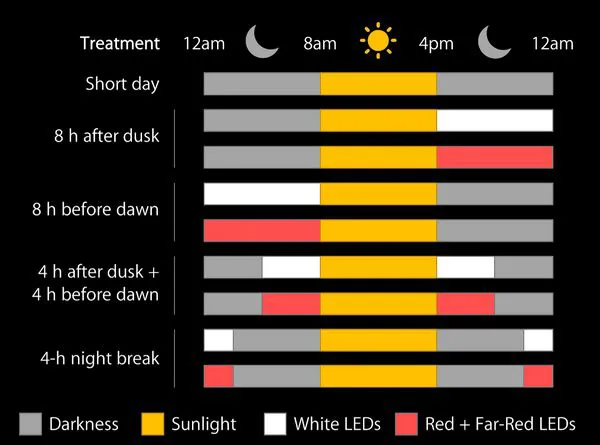Many important greenhouse floriculture crops are long-day plants, meaning they require long days and short nights (usually less than 8–10 hours of darkness) to produce flowers early. To shorten long nights and promote the flowering of long-day plants, growers can use dim photoperiodic lighting at the end of the day (day-extension lighting) or in the middle of the night (night-break or night-interruption lighting).
In the past decade, “flowering” LED lamps with custom light spectra, including red (R) + far-red (FR) light, have been commercially available for flowering applications, albeit at high prices. A more affordable option may be white LED lamps, which are mass-produced for general use. Developed for human vision, white LED lamps emit mostly visible red, green, and blue light but little FR light. There are pros and cons to both, in addition to cost considerations. “Flowering” LED lamps with FR light can result in rapid flowering of some crops like petunia but may also cause undesired stretching. White LED lamps may be less effective at promoting flowering than LED lamps with FR light but may produce more compact plants.
Experimental design
Plants can be sensitive to R or FR light during different parts of the night, so timing may also play a role in how effective white LED lamps can be at controlling flowering. To investigate the efficacy and optimal timing of white vs. R + FR LED lamps, a group of researchers performed, and then repeated, an experiment on four long-day plants: coreopsis ‘Early Sunrise,’ snapdragon ‘Liberty Classic Yellow,’ petunia ‘Easy Wave Burgundy Star,’ and petunia ‘Wave Purple Improved.’ The researchers transplanted seedlings into 4-inch pots filled with peat-perlite media and grew them in a greenhouse under nine lighting treatments
 Fig.1 Greenhouse setup of white and red + far-red lighting treatments.
Fig.1 Greenhouse setup of white and red + far-red lighting treatments.
The researchers grew plants under 8-hour short days (control, truncated with black cloth) with or without white or red + far-red (1:1) LED lamps operating for 8 hours after dusk, 8 hours before dawn, 4 hours after dusk + 4 hours before dawn, or 4 hours as a night break(Fig. 2). A digital timer controlled the timing of each lighting treatment. The researchers used layers of aluminum mesh to cover the R + FR LED lamps so that light intensity was similar across all treatments at around 2 μmol·m−2·s−1 with all colors included.
Results
Coreopsis ‘Easy Sunrise’ Plants did not flower under short days but flowered similarly under all lighting treatments (Fig. 3). At flowering, plants grown under white LED lamps were 18%–19% shorter than those grown under R + FR LED lamps.

Fig 2. Nine photoperiodic lighting treatments.
Snapdragon ‘Liberty Classic Yellow’ Compared to short days, both white and R + FR LED lamps promoted flowering. For 8-hour post-dusk and/or pre-dawn lighting, flowering was 10–20 days later under white LED lamps than under R + FR LED lamps (Fig. 3). However, for 4-hour night-break lighting, flowering was similar under the two lamp types. White LED lamps were most effective as 8-hour pre-dawn lighting. At flowering, white LED lamps increased branching by 30%–122% compared to R + FR LED lamps, no matter the timing.
Petunia ‘Easy Wave Burgundy Star’ All lighting treatments promoted flowering compared to short days. Flowering was 10–15 days later under white LED lamps than under R + FR LED lamps (Fig. 3). For both lamp types, flowering was 6–10 days earlier under 8-hour post-dusk and/or pre-dawn lighting than under 4-hour night-break lighting. For 8-hour post-dusk and/or pre-dawn lighting, plants grown under white LED lamps had 54%–86% more branches at flowering than those grown under R + FR LED lamps.
Petunia ‘Wave Purple Improved’ Plants flowered earlier under all lighting treatments compared to short days. For 8-hour post-dusk and/or pre-dawn lighting, plants grown under white LED lamps flowered 13–14 days later compared to R + FR LED lamps (Fig. 3). However, flowering was similar under both lamp types when delivered as 4-hour night-break lighting. For white LED lamps, the light timing did not matter, but under R + FR LED lamps, flowering was faster under 8-hour post-dusk lighting than under 4-hour night-break lighting. Branching was similar under all lighting treatments.

Takeaways
The results show that while white LED lamps may not produce flowers as early in FR-sensitive crops such as snapdragon and petunia, they show the potential to improve compactness and branching. They may be a cost-effective photoperiodic lighting option for plants such as coreopsis, that when grown under white LEDs, were shorter and flowered similarly to those grown under R + FR LEDs. As for the optimal timing of the different lamps, the researchers found that for white LEDs, the flowering of all crops was the earliest when operated for 8 hours before dawn. For R + FR LEDs, 8-hour post-dusk and/or pre-dawn lighting was generally more effective than 4-hour night-break lighting.
For more information 
American Floral Endowment
+1 (703) 838-5211
www.endowment.org










